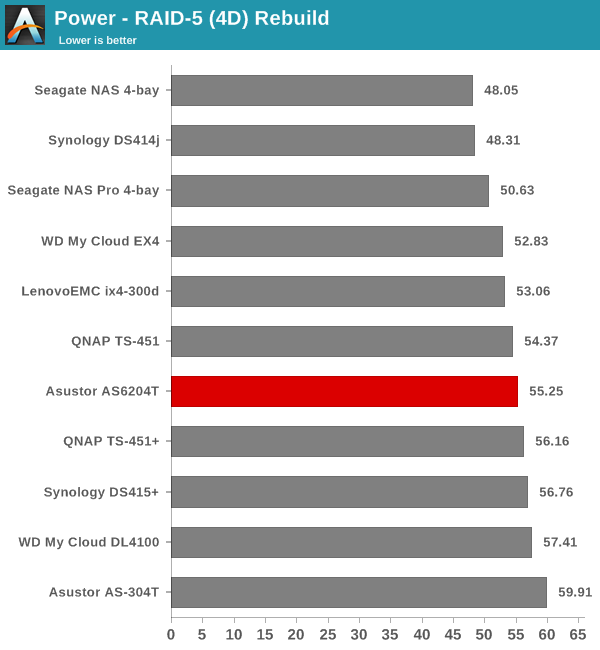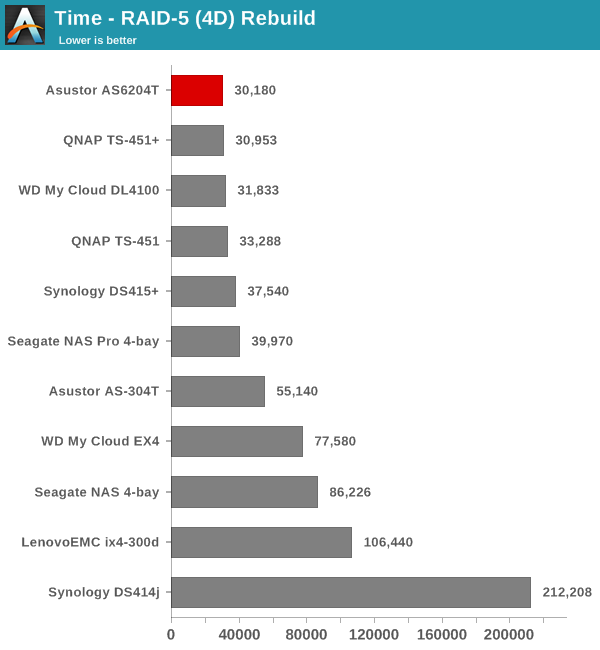Asustor AS6204T Braswell NAS Review
by Ganesh T S on November 5, 2015 8:00 AM ESTMiscellaneous Aspects and Final Words
In order to keep testing consistent across all 4-bay units, we performed all our expansion / rebuild testing as well as power consumption evaluation with the unit configured in RAID-5. The disks used for benchmarking (Western Digital WD4000FYYZ) were also used in this section. The table below presents the average power consumption of the unit as well as time taken for various RAID-related activities. In the general state with the hard disk powered on, but not actively reading or writing data, the power consumption was around 47 W, though it dropped to around 14 W with the disks in sleep mode.
| Asustor AS6204T RAID Expansion and Rebuild / Power Consumption | ||
| Activity | Duration (HH:MM:SS) | Avg. Power (W) |
| Single Disk Init | - | 19.94 W |
| JBOD to RAID-1 Migration | 08:08:00 | 31.27 W |
| RAID-1 (2D) to RAID-5 (3D) Migration | 17:31:00 | 43.65 W |
| RAID-5 (3D) to RAID-5 (4D) Expansion | 18:50:00 | 54.53 W |
| RAID-5 (4D) Rebuild | 08:23:00 | 55.25 W |
The graphs below show the power consumption and rebuild duration when repairing a RAID-5 volume for the various 4-bay NAS units that have been evaluated before.


The Asustor AS6204T is not the most power-efficient NAS around. The ARM-based 4-bay NAS units perform better in that respect. However, Asustor continues to have the shortest rebuild duration for a RAID-5 volume among all the 4-bay NAS units that we have tested before.
Concluding Remarks
Asustor became the first vendor to bring a Braswell-based NAS to the market with the AS6xxx series. The capabilities of the unit make it ideal for power users, SOHOs and SMBs. Since the AS6204T is based on the latest Braswell platform and uses the quad-core Celeron N3150, there is a slight pricing premium over the other 4-bay NAS units based on Intel platforms. With a street price of $670, it is approximately in the same ballpark as the recently reviewed QNAP TS-451+.
Asustor's ADM OS (v2.5 was used in our review) has been receiving numerous fixes and feature additions over the last year. One of the things that I like about Asustor is their prompt attention to feedback and bug reports, as well as speedy resolution of reported issues. Asustor knows that they have a lot of catching up to do in terms of OS features and performance. However, it is good from a consumer viewpoint that they are taking all efforts to bridge that gap as soon as possible.
Coming to the performance aspects, we find that CIFS read performance is very good, while write performance could definitely do with some improvements. NFS support, on the other hand, leaves a lot to be desired (both in terms of performance as well as supported features such as server side locks). The good aspect is that a beta release with a few fixes is already in our hands. The fixes will be migrating to a stable release shortly.
The AS6204T also comes with a HDMI 1.4b port and bundled media playing apps. The NAS can also be used as a media player for 4K videos with support for multi-channel audio over SPDIF as well as HDMI. The presence of AES-NI enables powerful encryption capabilities at a reasonable price point. The unit ships with 4GB of RAM, but users can upgrade easily to 8GB (the unit has two SO-DIMM slots). This could be important if a lot of apps end up running on the NAS simultaneously. Unlike competitors who provide a 2-year warranty for this class of products, Asustor advertises a 3-year warranty for the AS6204T.
Coming to the business end of the review, Asustor's top-end Braswell NAS is power efficient, extensible and performs in an acceptable manner. There is obviously scope for improvement on the software side - both in terms of performance as well as feature set. However, having observed the evolution of ADM over the last couple of years and the commitment shown by Asustor, I can say that they are on the right track.











29 Comments
View All Comments
extide - Thursday, November 5, 2015 - link
I think Purch could handle that expense. Anandtech isn't a little teensy website anymore, remember.DanNeely - Thursday, November 5, 2015 - link
Unless your preferred solution is either the Toms Hardware (picked on only because I'm not sure what else Purch already owns) comment system reskinned to Anandtech colors or something completely off the shelf like Discuss; that might not be the best idea. I'm very leery of handing the job off to a corporate overlord who bought the site on the assumption of being able to pull extra money out of it and which has already triggered multiple complaints from readers about overly intrusive advertising.milkod2001 - Thursday, November 5, 2015 - link
You could possibly contact Purch: http://purch.com/#contact-general(It own this website) and request it there. For such reputable company it is shame there is not edit option. It should not take more then 1 day to implemented it or just install DISQUS
Namisecond - Monday, December 7, 2015 - link
Don't underestimate the time it may take to transfer all the user accounts over. If the tools work fine and everything goes well in a single pass, it could take a day. If there are serious problems, might take several days to over a week.extide - Thursday, November 5, 2015 - link
Perhaps it refers to the number of dual-core modules -- as that is how Intel builds those chips (in dual-core pairs)dtgoodwin - Thursday, November 5, 2015 - link
Please, please, could you review a moderately configured FreeNAS setup testing it the same way you do these? I know there are a tremendous amount of variables, and tuning available, but if you used the standard configuration of software, and chose a medium performance platform such as an i3, or core series Pentium or Celeron and tested it with 4 drives, it could be comparable.I run a 7 drive RAIDZ2 with 3TB WD REDs. I am almost always able to saturate a single GB link using CIFS and robocopy or Windows file copy whether reading or writing. I'm running a less than optimal setup as I have 15 TB of usable space, but only 8GB of RAM. My system with a SuperMicro board with ICMP, 2 GB NICs, a Pentium G2030, and a used SuperMicro case cost me about $650 not including the drives.
Black Obsidian - Thursday, November 5, 2015 - link
I'm sure they could write such a feature, but the first 17 pages would be component selection, installation, lexicon (vdev, pool, stripe size, etc.), Shell Commands 101, and so forth.And none of it would say anything new. Anyone running--or considering running--FreeNAS knows its performance capabilities, and anybody seriously considering a Synology/QNAP/Asustor product is going to be in a coma by the third page of such a feature.
DanNeely - Thursday, November 5, 2015 - link
They wouldn't have to write those pages if they didn't want to. Just set general requirements and ask the hardware partners to donate a build as usual; or punt farther and get an entry level prebuilt freenas box from that company that's been selling them for years (albeit at a price that makes Synology/QNAP boxes look cheap). Default to RAIDZ5 to maintain parity with the rest of their 4 bay NAS reviews. Stick to setting it up via the installer/web config panel. The whole point of a product like freenas vs roll your own is that for typical nas use cases the user should never need to drop down to the shell or need to understand all of the magic behind the scenes. A single page on what ZFS does better than ETX4 on most linux based nases is really all that's needed.Navvie - Friday, November 6, 2015 - link
HP Microserver G1620T. Upgrade RAM to 8GB. Hardware selection done.FreeNAS/nas4free on USB stick. Default ZFS options that the web interface presents.
AnandTech seems to be making a big thing of NAS devices these days, ignoring the build your own device option is silly. Even if somebody is set on buying an off the shelf unit, it would be nice to see how much better it performs (or not) compared to a BYOD.
DCide - Thursday, November 5, 2015 - link
For some reason Asustor always reminds me of the words stupid or stupor. Probably not ASUS' finest branding moment.